Huhu beetle
The huhu beetle (Prionoplus reticularis) is a longhorn beetle endemic to New Zealand. It is the heaviest beetle found in New Zealand.
| Huhu beetle | |
|---|---|
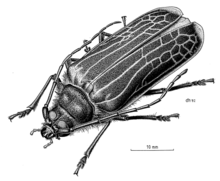 | |
| Prionoplus reticularis illustration by Des Helmore | |
| Scientific classification | |
| Kingdom: | |
| Phylum: | |
| Class: | |
| Order: | |
| Family: | |
| Subfamily: | |
| Genus: | Prionoplus |
| Species: | P. reticularis |
| Binomial name | |
| Prionoplus reticularis White, 1843 | |
Māori name
To Māori, the larval form is known as huhu (also tunga haere, tunga rākau) with the adult stage known as pepe-te-muimui.[1][2] However, the larval and adult forms are commonly referred to as the huhu grub and huhu beetle, respectively.
As the huhu larva reaches maturity it ceases to bore in wood and casts its skin. This still edible stage is known in Maori as tataka. It then develops wings and legs, and while it is still white, it is known as pepe. Finally, it emerges and flies off to reproduce and is known as tunga rere.[2]
Life cycle
Female adult huhu beetles oviposit their 3mm cigar-shaped eggs in clutches of 10–50, though up to 100 may be found.[3][4][5] Eggs are laid in cryptic sites or in cracks in the bark of fallen wood.[5] In laboratory conditions of 20°C ± 2°C and a relative humidity of c. 75%, eggs hatched in 23 ± 2 days.[5]
Before hatching, the larva can be seen to move inside the egg and will break free from the egg using its mandibles to pierce the chorion of the egg and then enlarging the opening by chewing, although the chorion itself is not ingested.[5] Setae that are found on abdominal segments 1-6 assist in providing support as the larva leaves the egg and excavates the initial gallery.[5]
The whitish-coloured larvae measure up to 70 millimetres (2.8 in) long and normally feed on dead wood of gymnosperms (mainly native and introduced conifers) associated with lowland podocarp forest.[6] Larval duration of P. reticularis is two to three years in the wild.[3] Under laboratory conditions, larval duration has been reduced to c. 250 days using an artificial diet and maintaining a temperature of 20°C.[7] In its final instar the larva moves to within 7.5 - 10cm of the surface of the wood before constructing the pupal chamber.[5] The pupal chamber is constructed by enlarging the diameter of the normal gallery over a period of one to three days. This process creates fragments of wood similar to wood shavings about 3cm by 1cm in size which are then packed into the larval gallery to form a plug.[5] Once the plug is completed the larva lines the walls of the pupal chamber with the last frass voided from its gut.[5] The larva then undergoes a resting period of around ten to fifteen days where the abdominal segments contract and the body darkens slightly whereupon it moults into a pupa.[5]
The pupal phase lasts around 25 days with gametogenesis being completed during this stage.[5][8] Eclosion occurs with a rupture along the frontal suture followed by a longitudinal rupture to the posterior border of the mesothorax.[5] The head, feet and wings are freed during arching movements of the body through the ruptured cuticle.[5] The emerged adult may then enter an inactive period of three to five days prior to creating an exit tunnel out of the pupal cavity.[5]
Following pupation and emergence, the adult beetle does not eat and lives for approximately two weeks.[2]
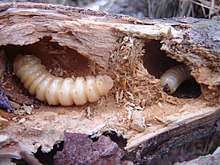 Huhu larvae in wood
Huhu larvae in wood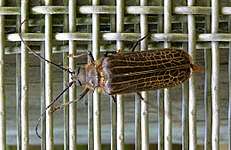 Huhu beetle (wire mesh 8mm spacing)
Huhu beetle (wire mesh 8mm spacing)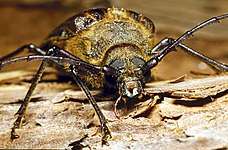 Huhu beetle (front)
Huhu beetle (front)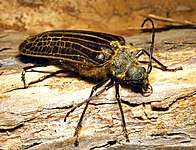 Huhu beetle
Huhu beetle.png) The head and prothorax of a female P. reticularis
The head and prothorax of a female P. reticularis._01.png) Eggs of P. reticularis
Eggs of P. reticularis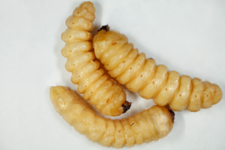 Larvae of P. reticularis
Larvae of P. reticularis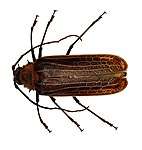 Female huhu beetle
Female huhu beetle
Behaviour
The beetles are nocturnal and are attracted by the lights of dwellings as noted by Hudson in 1892 "it is greatly attracted to light, and this propensity frequently leads it on summer evenings to invade ladies' drawing-rooms, when its sudden and noisy arrival is apt to cause much needless consternation amongst the inmates".[9][10] They have powerful mandibles, which can produce a painful bite.
Adult females of P. reticularis produce an olfactory cue which attract adult males to the female.[11] Adult individuals of both sexes will show a display behaviour if disturbed with the head jutting forward, mandibles opening to their full extent, antennae flailing and the head being raised and lowered.[11] High intensity displays between individuals may lead to combat with preliminary grappling occurring with fore legs which usually results in an individual being thrown onto its back. Any object coming into contact with the mandibles is seized frequently resulting in the loss of appendages.[11]
As a food source
The larvae of P. reticularis are edible, with a long history of indigenous consumption, and their flavour has been described as like buttery chicken[12] or peanut butter.[13] There are different names in Māori for grubs at different stages of development, for example young larvae still actively feeding on timber are called tunga haere or tunga rakau, while full grown grubs which have ceased to feed and are preparing to pupate are called tataka and are the most prized (because there is no undigested wood pulp inside of them at this point). Huhu grubs may be consumed either raw or traditionally cooked in a hāngi, and are an especially rich source of fat in the New Zealand wilderness.[14]
See also
References
- "pepe-te-muimui". maoridictionary.co.nz. Retrieved 3 September 2017.
- Best, Elsdon (1902). "Art. V.—Food Products of Tuhoeland: being Notes on the Food-supplies of a Non-agricultural Tribe of the Natives of New Zealand; together with some Account of various Customs, Superstitions, &c., pertaininy to Foods". Transactions and Proceedings of the Royal Society of New Zealand. 35: 64. Retrieved 20 August 2011.
- Miller, David; Walker, Annette (1984). Common insects in New Zealand (Rev. ed.). Wellington [N.Z.]: Reed. ISBN 0589014803. OCLC 12748887.
- "Huhu beetle". Te Papapa. Retrieved 2 September 2017.
- Edwards, John S. (1961). "Observations on the biology of the immature stages of Prionoplus reticularis White (Col. Ceramb.)" (PDF). Transactions of the Royal Society of New Zealand. 88: 727–731 – via RSNZ.
- John S Edwards (1959). "Host Range in Prionoplus reticularis" (PDF). Transactions of the Royal Society of New Zealand. 87 (Parts 3 and 4): 315–318.
- Rogers, David J.; Lewthwaite, Sonya E.; Dentener, Peter R. (2002). "Rearing huhu beetle larvae,Prionoplus reticularis(Coleoptera: Cerambycidae) on artificial diet". New Zealand Journal of Zoology. 29 (4): 303–310. doi:10.1080/03014223.2002.9518314. ISSN 0301-4223.
- EDWARDS, JOHN S. (1 December 1961). "On the Reproduction of Prionoplus reticularis (Coleoptera, Cerambycidae), with General Remarks on Reproduction in the Cerambycidae". Journal of Cell Science. s3-102 (60). ISSN 0021-9533.
- "Huia". The Official World Wildlife Fund Guide to Extinct Species of Modern Times. 1. Beacham Publishing. 1997. pp. 63–65.
- Hudson, G. V. (George Vernon) (1892). An elementary manual of New Zealand entomology; being an introduction to the study of our native insects. Smithsonian Libraries. London, West, Newman & Co.
- Edwards, John S. (1961). "Observations on the ecology and behaviour of the huhu beetle, Prionoplus reticularis White.(Col. Ceramb.)". rsnz.natlib.govt.nz. Transactions and Proceedings of the Royal Society of New Zealand. p. 733–741. Retrieved 11 July 2018.
- "Weird Food from around the World". 2008. Retrieved 18 July 2008.
- "George Gibbs, 'Insects – overview - In the bush', Te Ara - the Encyclopedia of New Zealand". 2007. Retrieved 12 February 2019.
- "Te Papa-Tai Awatea/Knowledge Net". Retrieved 12 February 2019.
External links
| Wikispecies has information related to Huhu beetle |
| Wikimedia Commons has media related to Huhu beetle. |
- Landcare Research - data